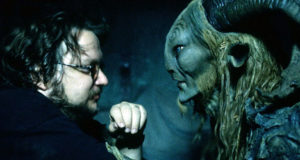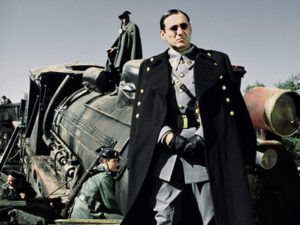
Pan’s Labyrinth (2006): The Journey Behind Guillermo Del Toro’s Dark Fairytale
Guillermo del Toro was born on October 9, 1964 in Guadalajara, Jalisco in Mexico. He was raised in a Catholic household and described his first years in life as “morbid”, stating that they made him absolutely intolerant of authoritarian figures. Del Toro developed an interest in making short dark fantasy films with his father’s Super 8mm camera since he was only eight years old and created about 10 short films till high school. He later attended the film school, Centro de Investigación y Estudios Cinematográficos, in Guadalajara, from where he graduated in 1983. In the mid-1980s, del Toro began shooting horror short films such as Doña Lupe (1985) and Geometría (1987) and also participated in La Hora Marcada, a Mexican horror TV show that aired from 1988 to 1990. This is where he collaborated with Alfonso Cuarón and Emmanuel Lubezki. Del Toro also specialized in film makeup under the guidance of Dick Smith (legendary makeup artist for The Exorcist) and eventually worked on various films as a makeup artist during the 1990s. His debut feature film was Cronos (1993), a superbly executed low-key Mexican tale about vampires. Winner of the critics’ prize at the Cannes Film Festival, Cronos was the start of a filmmaker who seems to be inspired by the classic tales of The Brothers Grimm and Charles Perrault, the cinema of Alfred Hitchcock and James Whale, as well as the literature of Lewis Carroll and Charles Dickens.
Guillermo followed Cronos with his first dive into Hollywood, Mimic (1997). Despite the film’s great scares out of mutant bugs terrorizing New York City, Guillermo felt unhappy with fulfilling Hollywood studio demands. After returning to Mexico, del Toro formed his own production company, The Tequila Gang, and started working on more personal film. Shot in Spain and produced by Pedro Almodóvar and his brother Agustín Almodóvar, The Devil’s Backbone (2001) is an ambitious story set during the end of the Spanish Civil War. With the help of filters and a mobile camera, del Toro created sepia-toned visuals that evoked a chilling universe over the politically metaphorical events taking place in a haunted boys’ school for Republican Army orphans. Praised for its dense atmosphere and complex themes, The Devil’sBackbone confirmed del Toro’s artistic ambitions. As years went by, Guillermo developed a very distinctive style composed by a unique blend of fantasy, horror and science fiction. Preferring to vanish a bit from Hollywood and to craft another dark fairy tale in the vein of The Devil’s Backbone, del Toro would focus his attentions on the production of his magnum opus, Pan’s Labyrinth (2006).
mutant bugs terrorizing New York City, Guillermo felt unhappy with fulfilling Hollywood studio demands. After returning to Mexico, del Toro formed his own production company, The Tequila Gang, and started working on more personal film. Shot in Spain and produced by Pedro Almodóvar and his brother Agustín Almodóvar, The Devil’s Backbone (2001) is an ambitious story set during the end of the Spanish Civil War. With the help of filters and a mobile camera, del Toro created sepia-toned visuals that evoked a chilling universe over the politically metaphorical events taking place in a haunted boys’ school for Republican Army orphans. Praised for its dense atmosphere and complex themes, The Devil’sBackbone confirmed del Toro’s artistic ambitions. As years went by, Guillermo developed a very distinctive style composed by a unique blend of fantasy, horror and science fiction. Preferring to vanish a bit from Hollywood and to craft another dark fairy tale in the vein of The Devil’s Backbone, del Toro would focus his attentions on the production of his magnum opus, Pan’s Labyrinth (2006).
Pan’s Labyrinth unravels through the eyes of Ofelia (Ivana Baquero), a daydreaming and imaginative little girl who is commanded by her stepfather, Captain Vidal (Sergi López) and forced to stay at a rural military outpost in fascist-ruled Spain. Powerless and lonely in a place of atrocious cruelty, Ofelia lives out her own dark fable as she faces monsters both supernatural and human. The story takes us back to 1944, the 12 year-old Ofelia arrives with her pregnant mother Carmen (Ariadna Gil) at an isolated farmhouse in Northern Spain. Here, between the dark woods and haunted atmosphere, her new stepfather Vidal has set up a fort to haunt leftover anti-fascist republican rebels from the Civil War. In her new home, Ofelia immediately bonds with Mercedes (Maribel Verdú), Vidal’s humble housekeeper. Mercedes secretly aids the rebels, which include her brother Pedro (Roger Casamajor). While the adults are fully immersed in their turbulent dramas, Ofelia has her own problems of a different sort.
For Ofelia, a girl who loves old books with fantastic stories, her new home is both a beautiful blessing and an evil curse. She is immediately intrigued by a mysterious old stone labyrinth located behind Vidal’s fort. Though Mercedes (Maribel Verdú) warns her not to go inside, Ofelia is lured by a magical small fairy. Once there, she meets the faun Pan (Doug Jones). The faun tells Ofelia that she is a long-lost underworld princess who has finally come to return to her kingdom. All she has to do is complete three magical tasks. He gives Ofelia a magic book, whose blank pages will reveal her missions. The tasks aren’t simple, and they have brutal consequences when not done right. While the rebel hunt intensifies in the mountains, and her mother’s pregnancy turns dangerous, Ofelia bravely pursues her magical tasks with strong passion and sublime effort. She retrieves a key from the stomach of a giant frog and also steals a dagger from a child-eating monster’s lair. These tasks are filmed by del Toro like mini-epic tales, flooding over with dramatic tension and majestic endings, as Ofelia sets herself against the darkness of evil. One of the adults says to her: “The world isn’t like your fairy tales. The world is a cruel place”. They simply don’t understand that Ofelia’s fairy tales are as cruel as anything she encounters in our reality.
She is immediately intrigued by a mysterious old stone labyrinth located behind Vidal’s fort. Though Mercedes (Maribel Verdú) warns her not to go inside, Ofelia is lured by a magical small fairy. Once there, she meets the faun Pan (Doug Jones). The faun tells Ofelia that she is a long-lost underworld princess who has finally come to return to her kingdom. All she has to do is complete three magical tasks. He gives Ofelia a magic book, whose blank pages will reveal her missions. The tasks aren’t simple, and they have brutal consequences when not done right. While the rebel hunt intensifies in the mountains, and her mother’s pregnancy turns dangerous, Ofelia bravely pursues her magical tasks with strong passion and sublime effort. She retrieves a key from the stomach of a giant frog and also steals a dagger from a child-eating monster’s lair. These tasks are filmed by del Toro like mini-epic tales, flooding over with dramatic tension and majestic endings, as Ofelia sets herself against the darkness of evil. One of the adults says to her: “The world isn’t like your fairy tales. The world is a cruel place”. They simply don’t understand that Ofelia’s fairy tales are as cruel as anything she encounters in our reality.
The horror of the real world lies in Falangist Spain with the menacing Captain Vidal who takes extreme pleasure in torture, constantly preparing his tool kit and reciting his own speeches to demonstrate superiority. Vidal is a man who is obsessed with the continuation of his “privileged” bloodline. Pan’s Labyrinth successfully and perfectly captures the passion of classical children’s literature; combining blissful amounts of fantasy with moments of real horror, all with an underlying and ultimately crucial message. Del Toro presents two different worlds, first is the brutal backdrop of the Civil War, the second one is Ofelia’s fantasy realm. The adults never see what the young girl is going through, and part of the experience of the film is questioning whether Ofelia is really witnessing magic or if these accounts are just temporary escapes from the tormented life with her stepfather. In both worlds, survival requires sacrifice and strong life lessons: regardless of which interpretation you choose to believe, the spell of Pan’s Labyrinth is completely unique. Guillermo crafted a multi-layered monster tale which scares, impacts and delights the viewer. The Mexican filmmaker tells the audience what it’s like to believe so thoroughly in your own imagination, while also reminding us that true heroism is filled with errors: “Since childhood I’ve been faithful to monsters – I have been saved and absolved by them. Because monsters, I believe, are patron saints of our blissful imperfection”.
torture, constantly preparing his tool kit and reciting his own speeches to demonstrate superiority. Vidal is a man who is obsessed with the continuation of his “privileged” bloodline. Pan’s Labyrinth successfully and perfectly captures the passion of classical children’s literature; combining blissful amounts of fantasy with moments of real horror, all with an underlying and ultimately crucial message. Del Toro presents two different worlds, first is the brutal backdrop of the Civil War, the second one is Ofelia’s fantasy realm. The adults never see what the young girl is going through, and part of the experience of the film is questioning whether Ofelia is really witnessing magic or if these accounts are just temporary escapes from the tormented life with her stepfather. In both worlds, survival requires sacrifice and strong life lessons: regardless of which interpretation you choose to believe, the spell of Pan’s Labyrinth is completely unique. Guillermo crafted a multi-layered monster tale which scares, impacts and delights the viewer. The Mexican filmmaker tells the audience what it’s like to believe so thoroughly in your own imagination, while also reminding us that true heroism is filled with errors: “Since childhood I’ve been faithful to monsters – I have been saved and absolved by them. Because monsters, I believe, are patron saints of our blissful imperfection”.
by Octavio Carbajal González

Octavio,
I’ve been on the road during the month of May and just returned home so I’m just now reading your perceptive review of Guillermo del Toro’s Pan’s Labyrinth.
I think Devil’s Backbone and Pan’s Labyrinth are his strongest films because, as you noted, they are not only fantasy, they also explore the horrors of history.
Hey Mark, hope you enjoyed your trip!.
Yes, Pan’s Labyrinth and Devil’s Backbone travel back and forth between fantasy and reality. Both are uniquely gorgeous films, filled with horrifying imagery. In terms of narrative and visuals, I couldn’t ask for more. There’s such great symbolism and poignant themes.
Nevertheless, Pan’s Labyrinth is my favorite.
Hi Octavio,
Thanks again for the fascinating review with many interesting details. Somehow I have never seen that film, but now, after your review, I’ll definitely watch it. I found out that the film was shot in Sierra de Guadarrama, which make it more interesting for me.
Hey Mika !, I appreciate your kind words. You’re one of VW’s most faithful readers.
I would like to go back in time just to feel once again the first impression that this film made on me (this feeling only happens with very few ones). I can almost assure that you’ll be pleasantly surprised. I loved the locations, Sierra de Guadarrama looks like a beautiful place.
Mark Kermode (one of my favorite film critics) made an interview to Guillermo back in 2007, and it’s insanely good. You can find it on Youtube, check it out after you watch the film…
By the way, I don’t mention it here, but Guillermo’s latest film “The Shape of Water” is my second favorite in his filmography. If you like PL, I recommend to continue with that one.
Telling a story from the perspective of a child isn’t something new on the fantasy genre, but this film is the singular exception. I only have good things to say about it- nice review!
Thanks for your comment, Adriana.
It’s really fantastic that a Mexican has been able to capture Spanish history in such an amazing and beautiful way.
Hello Octavio! A very good review of the film. Guillermo del Toro is a very talented director, who captured very well în this fantasy story the political context în Spain în the 44’s.
Thank you for reading, Enigel !
Glad you enjoyed Pan’s Labyrinth… As I told you before, “Los Tres Amigos” (Del Toro, Alfonso Cuarón and Alejandro G. Iñárritu) have established a radical, innovative and passionate change in contemporary cinema.
Hi Octavio,
A great review of one of my favorite “fantasy” movies. A daring and unnerving movie, but Del Toro somehow manages to guide the viewer through this dark tale with ease. Using the backdrop of the fight against the fascist forces of General Franco was a stroke of genius. Apparently the inspiration for that was the 11th September 2001 terrorist attacks on America.
Thank you for choosing to review this masterpiece.
Hey Serge, thank you !. Your thoughts are always appreciated.
Del Toro infuses his monster stories with propulsive passion, heart and soul. Inside his interviews and films commentaries, you can realize an insanely meticulous body of work.
He once said: “What interests me about fascism is that it is a black hole of free will. It is a system which isn’t necessarily unique, but it absolves brutality, it absolves the lack of morals and it absolves people of their own decisions. When they tell you ‘you can kill these people because they are Jews, reds or homosexuals, or whatever!’ In this world you can permit a brutal action on the base of collective advice; that is what scares me”.
You’re right. The 9/11 attacks were a big inspiration for this film, Guillermo saw that the response in America to the attacks was one of fear/obedience to an authoritarian mandate. He qualified George W. Bush as “a true master of horror”.
Great review of such tremendous masterpiece, Octávio! It was also very interesting to learn a few things about Guillermo del Toro’s biography. Excellent job!
Thanks for your words, Mimi.
I believe that this is exactly the kind of film that we need right now. While the world seems to be losing it’s mind, this story feels like a warm blanket that reliefs our senses.
A masterpiece.
Best fantasy film of the past decades, pure excellence. Interesting facts about the director.
Thanks for reading, Olli. Agree with you, this is an incomparably crafted fantasy film that reaches into the most obscure corners of every childhood fairy tale you once knew and manages to pull out the true duskiness behind them for your adult mind.
One of my favorite movies. Dark, beautiful, magical masterpiece!
Cheers, Patrick. Pan’s Labyrinth is a tremendously original, exquisitely poetic and technically accomplished beautiful film with a rare ability to immerse the adults into its fantasy world in a manner that very few can emulate, and even lesser when the story is a downright fairy tale.
Hi Octavio,
I’m not much of a fantasy fan, that’s why I never felt like watching this movie despite all the good things that I have heard about it. Most interesting about your review is the mention of the Falangist in Spain, because frankly, I had never heard of them before. For me (like for many I assume) that fascist period in Spain is just about Franco. That’s truly valueable information for me. I’m intrigued to have a closer look at the history of the Falangist Movement and then watch Pan’s Labyrinth. Thank you for this review!
Too bad the comment section closed under your articles? You have been fire lately. Bowie and Palestine 🔥💯
Hey Saliha,
Thank you so much for letting out this special article!. Pan’s Labyrinth merges fantastical horrors and extremely painful realities into a beautiful dark fable.
It feels like a strange combination of Jaromil Jires’ surreal film “Valerie and Her Week of Wonders” and Dario Argento’s “Phenomena”.
The political context of Pan’s Labyrinth is also what drived me to write about it, the story of Spain’s “Falange” is quite interesting. Franco found in the Falange a potential political party and an explicit ideology at hand for his use. In the film, Captain Vidal’s character feels like a personification of Franco himself. Vidal is one of the most memorable villains that I’ve ever seen on screen.
I strongly recommend you watch this film, can’t be missed!.